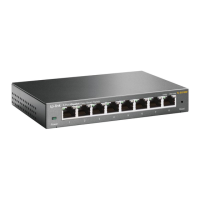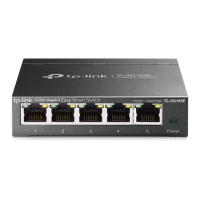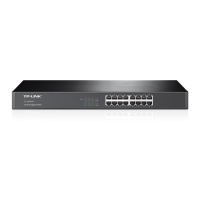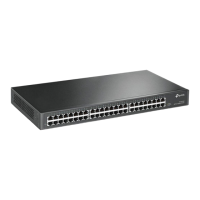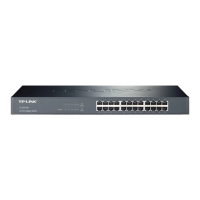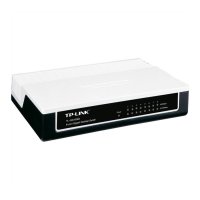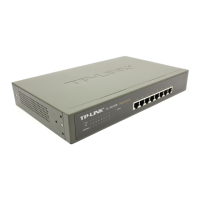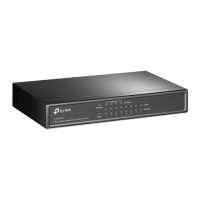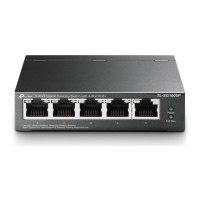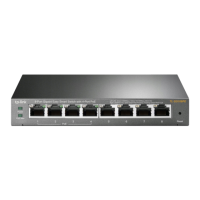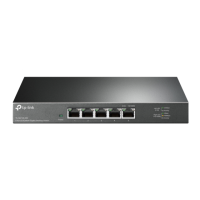Do you have a question about the TP-Link TL-SG108 and is the answer not in the manual?
Provides a seamless network connection with Gigabit Ethernet technology, increasing speed up to 1000Mbps.
Details Green Ethernet, IEEE standards, Auto-Sensing RJ45 ports, flow control, non-blocking architecture, IGMP snooping, QoS, Jumbo frames, and LEDs.
Describes the front panel of the TL-SG108 switch, including ports, Power LED, and link/activity LEDs.
Details the rear panel components, including the Kensington Security Slot and power socket.
Instructions for placing the switch on a flat desk, ensuring proper ventilation and power connection.
Steps for mounting the switch on a wall using the provided slots and screws.
Details the expected LED indicator behavior when the switch is powered on and initializes.
Details standards, topology, and protocol for the switch.
Covers data transfer rates, network media requirements, and port counts.
Check power cord connection and source if the Power LED remains off.
Verify cable connections, device status, and cable length for Link/Act LED issues.
Provides a seamless network connection with Gigabit Ethernet technology, increasing speed up to 1000Mbps.
Details Green Ethernet, IEEE standards, Auto-Sensing RJ45 ports, flow control, non-blocking architecture, IGMP snooping, QoS, Jumbo frames, and LEDs.
Describes the front panel of the TL-SG108 switch, including ports, Power LED, and link/activity LEDs.
Details the rear panel components, including the Kensington Security Slot and power socket.
Instructions for placing the switch on a flat desk, ensuring proper ventilation and power connection.
Steps for mounting the switch on a wall using the provided slots and screws.
Details the expected LED indicator behavior when the switch is powered on and initializes.
Details standards, topology, and protocol for the switch.
Covers data transfer rates, network media requirements, and port counts.
Check power cord connection and source if the Power LED remains off.
Verify cable connections, device status, and cable length for Link/Act LED issues.
| Jumbo frames | 16000 |
|---|---|
| Forwarding rate | 11.9 Mpps |
| MAC address table | 4000 entries |
| Jumbo frames support | Yes |
| Packet buffer memory | 1.5 MB |
| Maximum data transfer rate | 2 Gbit/s |
| Supported data transfer rates | 10/100/1000Mbps |
| 10G support | No |
| Networking standards | IEEE 802.1p, IEEE 802.3ab, IEEE 802.3i, IEEE 802.3u, IEEE 802.3x |
| Ethernet LAN data rates | 10, 100, 1000 Mbit/s |
| Packet transfer speed | 14880pps/148800pps/1488000pps |
| Connectivity technology | Wired |
| Ethernet interface type | Gigabit Ethernet |
| Switch type | Unmanaged |
| Power connector | DC-in jack |
| Installed SFP modules quantity | 0 |
| Basic switching RJ-45 Ethernet ports type | Gigabit Ethernet (10/100/1000) |
| Basic switching RJ-45 Ethernet ports quantity | 8 |
| Switching protocols | CSMA/CD |
| Certification | CE, FCC, RoHS |
| Product color | Black |
| Rack mounting | - |
| Storage temperature (T-T) | -40 - 70 °C |
| Operating temperature (T-T) | 0 - 40 °C |
| Storage relative humidity (H-H) | 5 - 90 % |
| Operating relative humidity (H-H) | 10 - 90 % |
| Package depth | 191 mm |
| Package width | 130 mm |
| Package height | 92 mm |
| Package weight | 510 g |
| Power source | DC |
| Input current | 0.6 A |
| Input voltage | 9 V |
| Power consumption (max) | 3.31 W |
| Harmonized System (HS) code | 85176990 |
| Depth | 101 mm |
|---|---|
| Width | 158 mm |
| Height | 25 mm |
